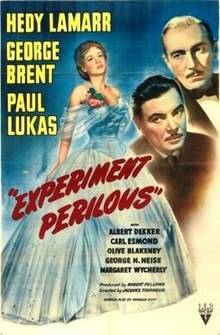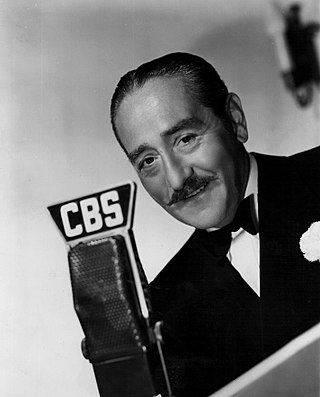
Adolphe Jean Menjou was an American actor. His career spanned both silent films and talkies. He appeared in such films as Charlie Chaplin's A Woman of Paris, where he played the lead role; Stanley Kubrick's Paths of Glory with Kirk Douglas; Ernst Lubitsch's The Marriage Circle; The Sheik with Rudolph Valentino; Morocco with Marlene Dietrich and Gary Cooper; and A Star Is Born with Janet Gaynor and Fredric March, and was nominated for an Academy Award for The Front Page in 1931.

Hedy Lamarr was an Austrian-born American actress and inventor. After a brief early film career in Czechoslovakia, including the controversial erotic romantic drama Ecstasy (1933), she fled from her first husband, Friedrich Mandl, and secretly moved to Paris. Traveling to London, she met Louis B. Mayer, who offered her a film contract in Hollywood. Lamarr became a film star with her performance in the romantic drama Algiers (1938). She achieved further success with the Western Boom Town (1940) and the drama White Cargo (1942). Lamarr's most successful film was the religious epic Samson and Delilah (1949). She also acted on television before the release of her final film in 1958. She was honored with a star on the Hollywood Walk of Fame in 1960.
The year 1944 in film involved some significant events, including the wholesome, award-winning Going My Way plus popular murder mysteries such as Double Indemnity, Gaslight and Laura.
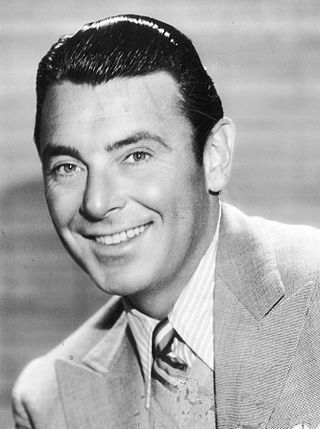
George Brent was an Irish-American stage, film, and television actor. He is best remembered for the eleven films he made with Bette Davis, which included Jezebel and Dark Victory.

Ecstasy is a 1933 Czech erotic romantic drama film directed by Gustav Machatý and starring Hedy Lamarr, Aribert Mog, and Zvonimir Rogoz. Machatý won the award for Best Director for this film at the 1934 Venice Film Festival.
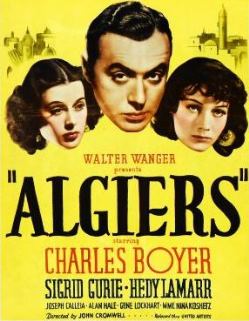
Algiers is a 1938 American drama film directed by John Cromwell and starring Charles Boyer, Sigrid Gurie, and Hedy Lamarr. Written by John Howard Lawson, the film is about a notorious French jewel thief hiding in the labyrinthine native quarter of Algiers known as the Casbah. Feeling imprisoned by his self-imposed exile, he is drawn out of hiding by a beautiful French tourist who reminds him of happier times in Paris. The Walter Wanger production was a remake of the successful 1937 French film Pépé le Moko, which derived its plot from the Henri La Barthe novel of the same name.

John Loder was established as a British film actor in Germany and Britain before migrating to the United States in 1928 for work in the new talkies. He worked in Hollywood for two periods, becoming an American citizen in 1947. After living also in Argentina, he became a naturalized Argentinian citizen in 1959.

H. M. Pulham, Esq. is a 1941 American drama film directed by King Vidor and starring Hedy Lamarr, Robert Young, and Ruth Hussey. Based on the novel H. M. Pulham, Esq. by John P. Marquand, the film is about a middle-aged businessman who has lived a conservative life according to the routine conventions of society, but who still remembers the beautiful young woman who once brought him out of his shell. Vidor co-wrote the screenplay with his wife, Elizabeth Hill Vidor. The film features an early uncredited appearance by Ava Gardner. In February 2020, the film was shown at the 70th Berlin International Film Festival, as part of a retrospective dedicated to King Vidor's career.
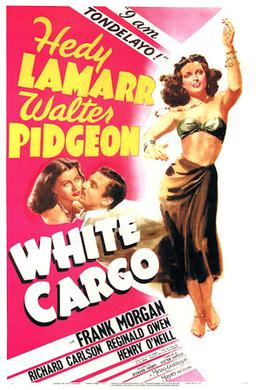
White Cargo is a 1942 American drama film starring Hedy Lamarr and Walter Pidgeon, and directed by Richard Thorpe. Released by Metro-Goldwyn-Mayer, it is based on the 1923 London and Broadway hit play by Leon Gordon, which was in turn adapted from the 1912 novel Hell's Playground by Ida Vera Simonton. The play had already been made into a British part-talkie, also titled White Cargo, with Maurice Evans in 1930. The 1942 film, unlike the play, begins in what was then the present-day, before unfolding in flashback.
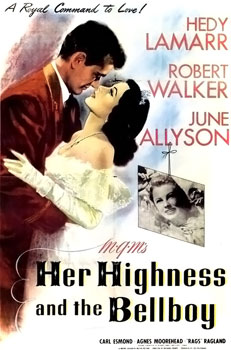
Her Highness and the Bellboy is a 1945 American romantic comedy film directed by Richard Thorpe and starring Hedy Lamarr, Robert Walker, June Allyson and Rags Ragland. Written by Richard Connell and Gladys Lehman, the film is about a beautiful European princess who travels to New York City to find the newspaper columnist she fell in love with six years earlier. At her posh New York hotel, she is mistaken for a maid by a kind-hearted bellboy. Charmed by his confusion, the princess insists that he become her personal attendant, unaware that he has fallen in love with her. Her Highness and the Bellboy was released by Metro-Goldwyn-Mayer in the United States on July 11, 1945.

The Strange Woman is a 1946 American historical melodrama film directed by Edgar G. Ulmer and starring Hedy Lamarr, George Sanders and Louis Hayward. It is based on the 1941 novel of the same title by Ben Ames Williams. The screenplay was written by Ulmer and Hunt Stromberg. Originally released by United Artists, the film is now in the public domain.
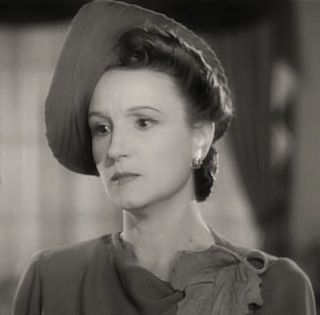
Olive Blakeney was an American actress.
Margaret Seymour Carpenter was the writer of the novel Experiment Perilous, a New York Times Bestseller in 1943. The novel was produced by RKO Radio Pictures as a film of the same name, Experiment Perilous, starring Hedy Lamarr, George Brent, and Paul Lukas. She was the daughter of George Rice Carpenter and his wife, Mary Seymour.

Abroad with Two Yanks is a 1944 American comedy film directed by Allan Dwan and starring Helen Walker, William Bendix and Dennis O'Keefe as the title characters. It was Bendix's third and final role in a film as a US Marine and the first of Dwan's three films about the United States Marine Corps.

Let's Live a Little is a 1948 American romantic comedy film directed by Richard Wallace and starring Hedy Lamarr, Robert Cummings and Anna Sten. Written by Howard Irving Young, Edmund L. Hartmann, Albert J. Cohen, and Jack Harvey, the film is about an overworked advertising executive who is being pursued romantically by his former fiancée, a successful perfume magnate, who is also the ad agency's largest client. While visiting a new client—a psychiatrist and author—to discuss a proposed ad campaign, his life becomes further complicated when the new client turns out to be a beautiful woman, who decides to treat his nervous condition.

The Female Animal is a 1958 American CinemaScope drama film directed by Harry Keller and starring Hedy Lamarr, Jane Powell, Jan Sterling and George Nader.
"Failed Experiments" is the nineteenth episode of the third season of the American television series Agents of S.H.I.E.L.D. Based on the Marvel Comics organization S.H.I.E.L.D., it follows Phil Coulson and his team of S.H.I.E.L.D. agents as they attempt to defeat Hive. It is set in the Marvel Cinematic Universe (MCU) and acknowledges the franchise's films. The episode was written by Brent Fletcher, and directed by Wendey Stanzler.

Bombshell: The Hedy Lamarr Story is a 2017 American biographical documentary film directed, written and co-edited by Alexandra Dean, about the life of actress and inventor Hedy Lamarr. It had its world premiere at the 2017 Tribeca Film Festival and released theatrically on November 24, 2017. The film was broadcast in the United States on the PBS biography series American Masters in May 2018. As of April 2020, it was also available on Netflix.

Sailor's Holiday is a 1944 American comedy film directed by William Berke and starring Arthur Lake, Jane Lawrence and Bob Haymes. It was produced and distributed by Columbia Pictures.

Elizabeth Inez Cooper was an American actress, noted at the time for closely resembling actress Hedy Lamarr. Before her Hollywood career, Cooper worked in a department store, engaged in modeling jobs and traveled worldwide. Producer Mervyn LeRoy discovered her at a nightclub in 1941, mistaking her for Lamarr. After being offered a professional acting contract, Cooper entered the film industry and studied dramatics, although initially could only secure minor roles.
